Having problems reading this email? View it in your browser >>
|
||
 |
||
|
||
Contents |
||
South Africa: dropping out of HIV care is deadly | ||
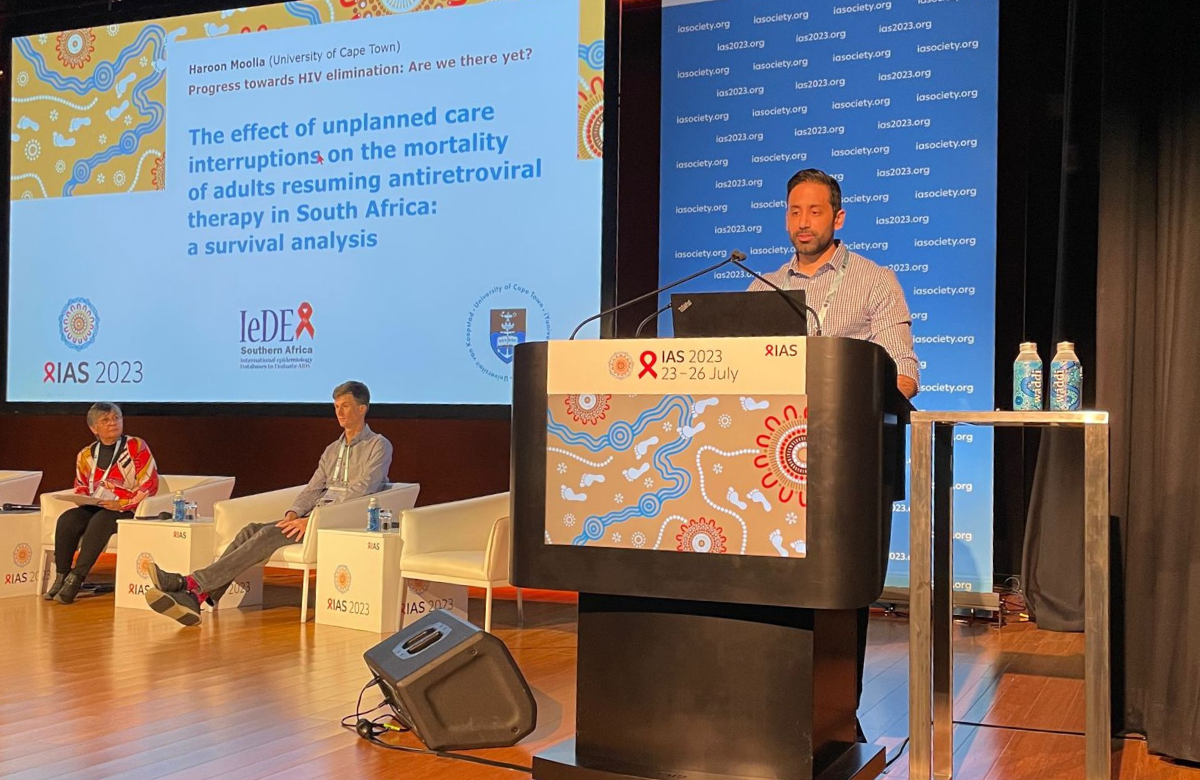 Dr Haroon Moolla at IAS 2023. Photo by Krishen Samuel. | ||
|
A study in South Africa found that people who did not attend HIV care for periods of more than six months were two to three times more likely to die within the study period than those who stayed in care continuously. The study was presented at the 12th International AIDS Society Conference on HIV Science (IAS 2023) in Brisbane, Australia, this week. Dr Haroon Moolla of the University of Cape Town and colleagues collected data from several large patient cohorts in South Africa from people who interrupted antiretroviral therapy (ART) and later resumed it. Data collection started in 2004 and finished at the end of 2019. The study did not look at all patients who left care and stopped treatment, only those who restarted. Care interruptions were defined as a gap of more than 180 days (nearly six months) between last accessing ART and resuming care. People were divided into two groups: those whose periods of missing care started in the first six months after their diagnosis and those who first dropped out of care later on. A total of 63,421 adults with HIV were included, contributing 188,358 person-years of data. The average age was 33 and more than two-thirds (68%) were women. Most people (64%) never interrupted their therapy. Of the 22,593 people who did, 39% started their first interruption within six months of diagnosis. The average length of time out of care was 22.8 months (nearly two years), with 25% resuming care within a year but another 25% stopping for more than three years. There were 3585 deaths during the study period. People interrupting then resuming ART had increased mortality, compared to those without an interruption. People whose first interruption occurred within six months of diagnosis had 3.08 times the risk of death subsequently occurring during the study period, and those whose first interruption occurred after six months had 2.47 times the risk. The mortality rate was 0.78% in people who did not interrupt their care (one death in 128 people per year) but 1.6% in people whose first interruption was more than six months after starting ART (one death in 62.6 people per year), and 1.9% (one in 52.6) in people who dropped out within the first six months. Dr Moolla commented, “The substantially increased mortality of those resuming ART after an interruption highlights the need to prioritise and support retention in care, particularly during the first six months of ART.” | ||
More options for second-line HIV treatment for children | ||
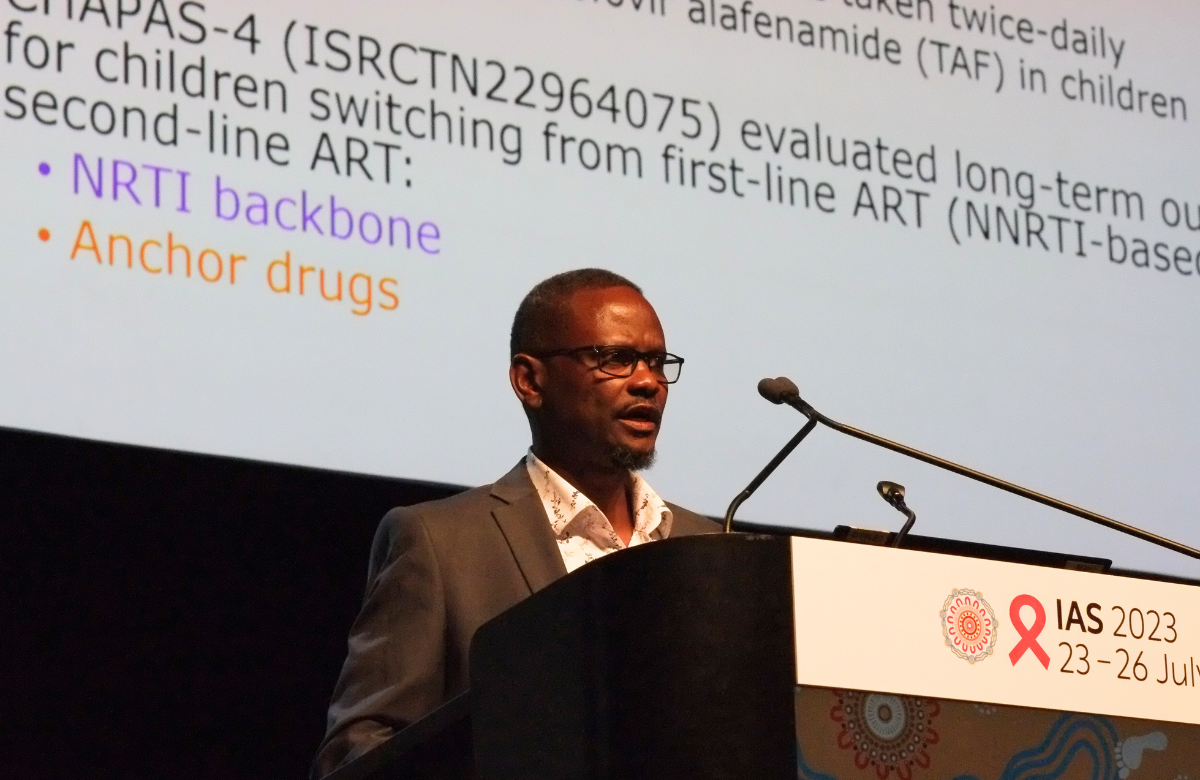 Dr Victor Musiime at IAS 2023. Photo by Roger Pebody. | ||
|
The findings of the Children with HIV in Africa – Pharmacokinetics and Acceptability of Simple second-line ART (CHAPAS-4) study were presented by Dr Victor Musiime of Makerere University at IAS 2023. Current options for second-line treatment are very limited for children living with HIV. Boosted lopinavir/ritonavir is taken twice daily, and there are minimal data on tenofovir alafenamide (TAF) in children. The CHAPAS-4 research took place at six trial sites in Uganda, Zambia, and Zimbabwe. There were 919 participants (497 boys and 422 girls), aged between 3 and 15, with a median age of 10. Rates of malnutrition in the group were moderate. The average CD4 count was 669, with an average viral load of 17,573. Most children had spent around six years on NNRTI first-line treatment. The children were randomised to one of two NRTI-backbone medicines:
Almost all (910) were also randomised to one of four anchor medicines:
Viral load suppression was defined as below 400, which remained high at 80% or above across all arms of the study. The study found five key things:
The CHAPAS-4 trial confirms World Health Organization guidelines which recommend dolutegravir as a second-line treatment for children. The findings highlight the need to develop a child-friendly fixed-dose combination of TAF and emtricitabine plus dolutegravir as an anchor medicine. Alternatively, darunavir/ritonavir or atazanavir/ritonavir could be used as the anchor. | ||
Very high HIV incidence among people who inject drugs in South Africa | ||
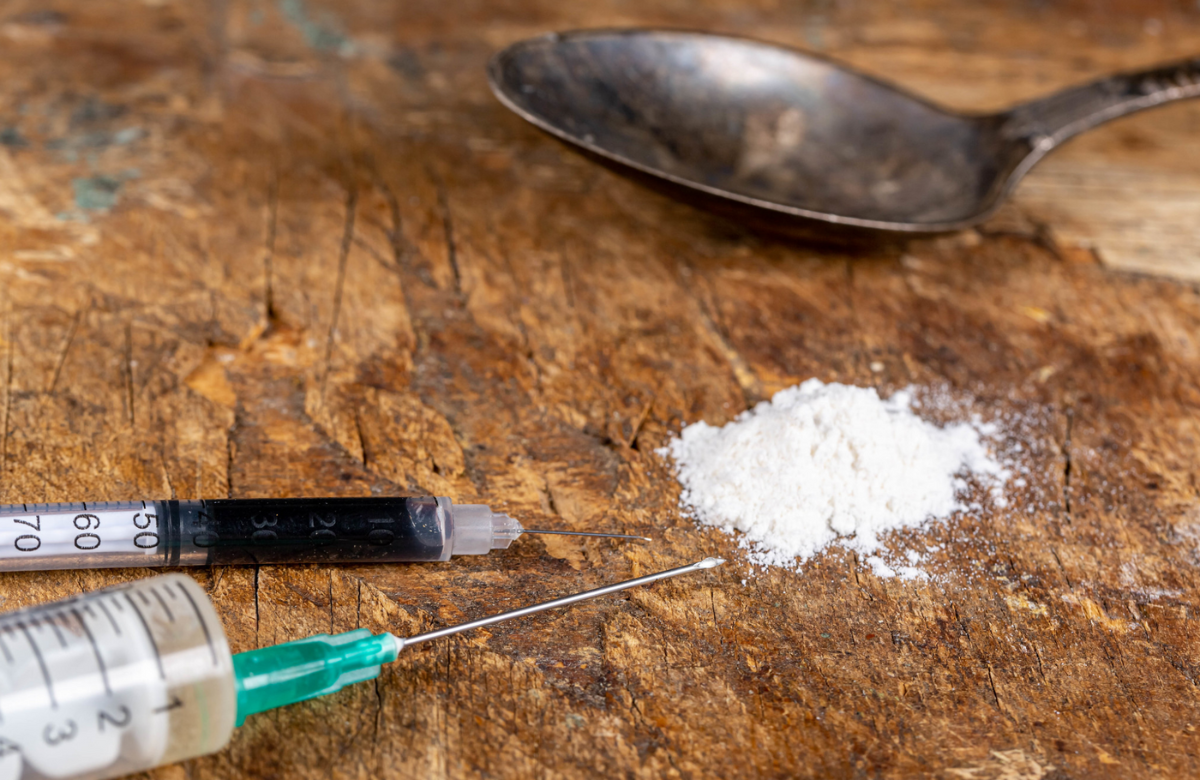 Photo by Marco Verch. Creative Commons licence. | ||
|
Despite having the largest HIV epidemic globally, new cases of HIV (incidence) among people who inject drugs has never been measured in South Africa. A recent review found incidence in high-income countries was 0.9%, whereas it was 3.2% in low- and middle-income countries. In South Africa, the proportion of people who inject drugs who are living with HIV (prevalence) is estimated to be 18%. Harm reduction services in the form of needle and syringe programmes became available in 2015. Opioid substitution therapy has been available since 2017, but it is estimated that less than 5% of those who need it currently get it. This study used programmatic data from harm reduction services in four South African provinces (Gauteng, KwaZulu-Natal, the Eastern and Western Cape) collected between 2019 and 2022 to estimate new cases of HIV among people who inject drugs. Most of the 31,873 people in the cohort were excluded from the analysis because they were known to be living with HIV, weren’t tested for HIV or were only tested once. HIV incidence was calculated in a sample of 2457 people who were HIV negative initially. Of this sample, most were from Gauteng (57%), men (90%), Black (72%), had a median age of 30 (77% were 35 or younger), were homeless or unstably housed (63%) and used heroin (97%). Very few people had received opioid substitution therapy – this ranged from none in the Eastern Cape and 0.5% in Johannesburg, to 6.4% in the Western Cape. A total of 300 people acquired HIV over a period of 2190 person-years, resulting in an HIV incidence rate of 13.7%. Risk of HIV acquisition varied by province, with Gauteng having the highest incidence (19%), followed by KwaZulu-Natal (17%). Incidence was lower in the Eastern Cape (6.3%) and Western Cape (3.4%). Younger age groups tended to have higher incidence rates than those aged over 35. People who had received opioid substitution therapy and a greater number of harm reduction packs had lower risks of HIV acquisition. Those who received opioid substitution therapy after being tested for HIV had a 62% reduction in the chances of acquiring HIV compared to those who had never received substitution therapy. Dr Artenie pointed out that services such as needle and syringe programmes and opioid substitution therapy have the potential to reduce this incidence rate. This research underscores the urgent need for increased funding for these services. | ||
Doravirine/islatravir just as effective as Biktarvy in previously untreated people | ||
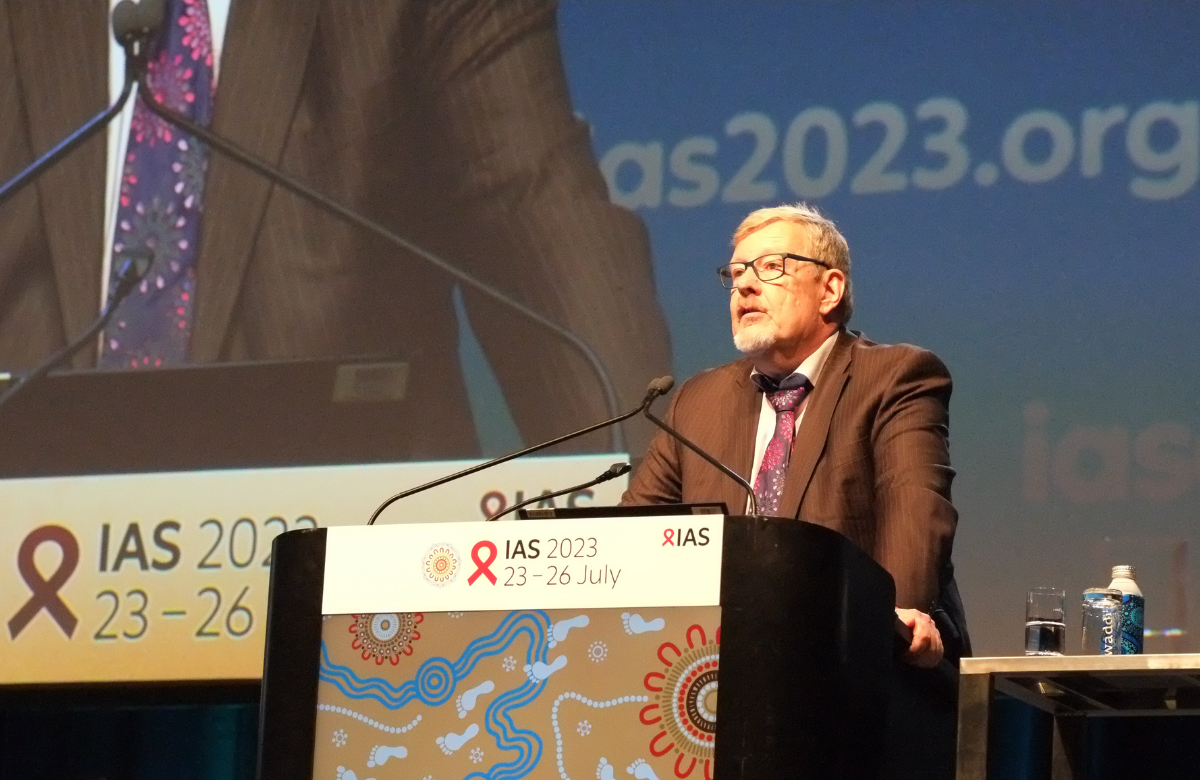 Professor Jürgen Rockstroh at IAS 2023. Photo by Roger Pebody. | ||
|
Islatravir is the first antiretroviral in a new class called nucleoside reverse transcriptase translocation inhibitors (NRTTIs). It persists in cells for much longer than other antiretrovirals and early development included studies of high doses given once a week. Development was paused in 2021 after it was found that people taking high doses in clinical trials had experienced falls in white blood cells. The effect was dose-related and development of islatravir resumed using lower doses. A phase 2b dose-ranging study that compared daily doses of 0.25mg, 0.75mg and 2.25mg found that doses of 0.75mg and 0.25mg resulted in equivalent rates of viral suppression when combined with doravirine. The 0.75mg dose was initially taken forward for larger phase 3 studies but after the development pause, the company developing islatravir, Merck, decided to focus on the 0.25mg dose. This week, Professor Rockstroh presented results of a phase 3 study that tested a 0.75mg dose of islatravir combined with doravirine. The study was almost fully recruited when islatravir development was paused. The study recruited adults with HIV who had not previously taken antiretroviral therapy, and who had a viral load above 500. The study excluded people with hepatitis B or any major drug resistance mutations. It recruited 597 people in 13 countries (32% in Europe, 22% in North America, 23% in Latin America and 18% in South Africa). Most participants were male (approximately 75% in each study arm) and just over half (57%) were White. Twenty per cent had CD4 counts below 200 and 18% in the doravirine/islatravir arm and 20% in the bictegravir arm had a baseline viral load above 100,000. Participants were randomised to receive either 100mg of doravirine and 0.75mg of islatravir once daily or bictegravir, emtricitabine and tenofovir alafenamide (Biktarvy) once daily. There was no significant difference in viral suppression at week 48; 88% in each study arm had viral load below 50. There was no significant difference in grade 3 or 4 toxicity (10% vs 11%) and only two participants withdrew from the study due to drug-related adverse events (both in the bictegravir arm). A phase 3 study is now comparing doravirine and a lower islatravir dose of 0.25mg to Biktarvy. | ||
Data analysis from Clinical Care Options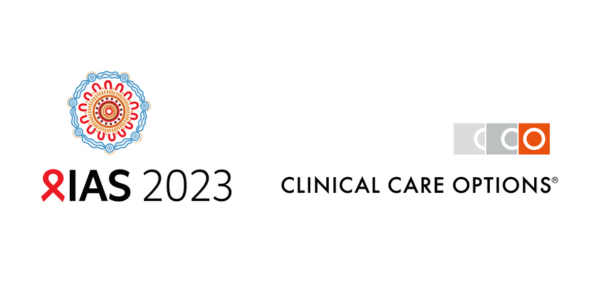
Engage in the analysis of data presented at IAS 2023, with rapid post-conference webinars by expert faculty on key HIV prevention strategies, treatment studies, and new and investigational treatment regimens, provided by Clinical Care Options. Watch the on-demand webinars, download the slides, and gain global perspectives with companion ClinicalThought commentaries. | ||
Connect with us |
||
Official conference partners |
||
|
NAM's news coverage of IAS 2023 has been made possible thanks to support from Gilead Sciences Europe Ltd and ViiV Healthcare. |
||
|
aidsmap is an award-winning, community-based organisation, which works from the UK. We deliver reliable and accurate HIV information across the world to HIV-positive people and to the professionals who treat, support and care for them.
NAM Publications
Cally Yard, 439 Caledonian Road, London N7 9BG Company limited by guarantee. Registered in England & Wales, number: 2707596 Registered charity, number: 1011220 To unsubscribe please click here Privacy Policy: www.aidsmap.com/about-us/confidentiality |